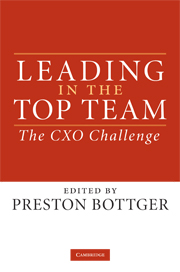Book contents
- Frontmatter
- Contents
- Figures
- Tables
- Contributors
- Editor's Acknowledgments
- 1 Introduction – Leading within and across the functions
- Section I The Business Imperatives
- Section II The CXOs: Within the Functions
- Section III The CEO and the Leadership Team – Pulling it all together
- 17 From CXO to CEO – The weight of accountability
- 18 The Chief Executive Officer – Orchestrating the whole
- 19 Relations Among CXOs – Competing priorities spell trouble
- 20 The Top Team – From executive group to executive team
- Conclusion
- Index
- References
20 - The Top Team – From executive group to executive team
Published online by Cambridge University Press: 19 August 2009
- Frontmatter
- Contents
- Figures
- Tables
- Contributors
- Editor's Acknowledgments
- 1 Introduction – Leading within and across the functions
- Section I The Business Imperatives
- Section II The CXOs: Within the Functions
- Section III The CEO and the Leadership Team – Pulling it all together
- 17 From CXO to CEO – The weight of accountability
- 18 The Chief Executive Officer – Orchestrating the whole
- 19 Relations Among CXOs – Competing priorities spell trouble
- 20 The Top Team – From executive group to executive team
- Conclusion
- Index
- References
Summary
On the first day of the retreat, one of the business line guys piped up, ‘If you, support-function guys, would just do this …’ The CEO said, ‘Hang on. We're all part of this company. If you're going to sit in this room and work on this team, you've got to drop this “we” and “they” … This is a collective effort.’ People got the message, and this has turned into a real team.
CXO, global motor companyTo support the CEO effectively, CXOs must often engage in combined action.
This chapter considers some of the obstacles to the pursuit of an integrated and coherent corporate agenda. We pull together some of the previous themes and propose ways of surmounting the barriers to collective action that are built into the social system.
Building on points made earlier in chapters 16 and 19, we can identify four practical challenges for the CEO, and for the CXOs in their work to support the CEO:
Handling the effects of the inevitable informal hierarchy within the top team, particularly when this pits CXOs against their line colleagues;
Ensuring that CXOs find the right balance between supporting their line colleagues and enforcing corporate-wide policies in their functional area;
Encouraging CXOs to broaden their thinking to act as full members of the top executive team;
Aligning the work of all CXOs with the entire corporate agenda.
Before exploring these four tasks in greater depth, it is useful to clarify the composition of the corporation's top team.
- Type
- Chapter
- Information
- Leading in the Top TeamThe CXO Challenge, pp. 377 - 388Publisher: Cambridge University PressPrint publication year: 2008

